How long does it take to “make” a tradition? A generation? Two? More? I’ll leave others to debate that, and confidently declare baking to be an established tradition in Coorg!
Of course, we have traditional preparations which are cooked in embers – a form of baking, as it were. But the baking I’m referring to here is the kind which involves the making of cakes, biscuits and the like. The ladies (perhaps some gentlemen too) of Coorg have a great fondness, and a definite talent, for baking. Cakes, meringues, pies, tarts, scones – you name it, they love to bake it! For as long as I can remember, it’s been almost de rigueur for this baking talent to be showcased at family events – engagements, weddings, naming ceremonies, and even at wakes. Some enterprising ladies have found profitable outlets for their talent by supplying delicious homemade chocolate cakes to local stores in Coorg.
In Pune, not long ago, I got to indulge in a host of tasty treats from some of the city’s excellent bakeries, many of which are run by Iranis, who brought their baking traditions with them when they migrated from Persia. Baking and patisserie have woven themselves into the culinary landscape in India through a medley of cultural influences – Persian, Portuguese, French, Dutch, Italian, and, of course, British.
In Coorg, the influence was mainly British, though some of the most outstanding commercially produced baked goods that my grandparents and parents generations enjoyed came in to Coorg from the bakeries of Mangalore, and also from Tellicherry and Kannur (Cannanore) in Kerala, where the influences are more mixed.
At the beginning of the last century, there was enough of a European presence in Coorg to require the establishment of provision stores that stocked ingredients necessary for their daily repast. Refined flour and sugar, baking powder, candied fruit, chocolate and cocoa were available in these stores.
It’s hardly surprising then, that these novelties caught the fancy of many an adventurous local cook. A friend recalls her mother determinedly baking biscuits in a small village near Ammathi in the 1930’s, probably working from a recipe found in a magazine. She used the lid of a cigarette tin as a cutter, and improvised some sort of contraption on the wood fired stove for an oven!
Speaking of remote corners – beginning in the 1920’s, my paternal grandparents spent a good part of their lives in the Andaman Islands, where grandfather was in the Forest Service. My grandmother, Bollu Thai, who as young bride, went from life in the relatively gentrified town of Mercara, to the wilds of the Andamans without batting an eyelid, filled our childhood with wonderful tales of the life their family led there. Of course, she made light of the hardship and danger they faced on a daily basis, turning every hair raising episode into a tale of adventure that had us on tenterhooks, even when we knew the ending. She was a truly gifted story teller, who left you begging for more, even if it was to retell a tale heard a hundred times before.
One episode that comes to mind here is of the time when some senior officers arrived from the mainland on a tour. A visit was scheduled to the far-flung island home of another Coorg family, also in the Forest Service. Imagine their surprise when the lady of the house greeted them with an impeccably laid out tea, complete with a freshly baked cake. Not to be limited by her rudimentary kitchen facilities, she had baked a cake in a large biscuit tin, buried in the burning hot sands of the beach!
It was from Bollu Thai that I learned that cake, eaten with condensed milk and cream was a legitimate food group. Wouldn’t she have loved pastel de tres leches!
My grandmother in Coorg, on the other hand, made an impeccable pound cake, and the best seed cake bar none. When the groceries were delivered home from the fancy store in town, Spencer’s, a tiny brown paper bag rustling and fragrant with caraway was a sure sign that we’d be eating seed cake in the next day or two. Nibbling on those seeds while helping my grandmother was something I loved to do. And carrying little bottles of vanilla and almond essence, clinking into the kitchen, anticipating which one she might choose that day seemed like a terribly important job. Grandma mixed her cakes by hand, by which I mean she actually stirred and mixed the batter with her bare hand, creaming the butter and sugar, mixing in the eggs, folding in the flour, scraping the sides of the mixing bowl. I like to think that’s where the magic lay. She also had a grand way of slicing a cake into doorstop sized slabs.This generous portioning extended to slicing bread too, and soft, pillowy loaves of bread from the local “Cosmos Bakery” disappeared rapidly in clouds of butter and homemade jams.
Early on in my parents’ army life, my mother had to make do with ovens fashioned from tall biscuit tins ingeniously designed with a sand tray at the base for better heat distribution. Precariously perched on a flickering kerosine stove, they did a great job of the birthday cakes, biscuits and jam tarts that my mother baked. The ovens were rough, but far more reliable than the temperamental and fragile domestic electric models that became available in the 1970’s.
It was 36 years ago that a certain Baby Belling oven arrived in our home, and life as we knew it was never the same. It was my late Aunt,Tara, a gifted baker herself, who first explained to this curious eight year old that the “Oz” in a recipe meant an ounce, a measure of weight. That dispelled any strange, wizardly notions I might have had in my mind, and I got down to the business of baking. I faithfully copied recipes out of my Aunt’s stacks of Australian Women’s Weekly , following her lead in trying out recipes like Maori Kisses and Valentine Pavlova. Oh! The exotic headiness of it all!
I spent countless hours feeding the little Baby Belling with all kinds of offerings, mainly from recipes by that grand old lady of British cooking, Marguerite Patten. Later, there was Patricia Dunbar, Mary Berry, the Brothers Roux, and so many others to turn to for inspiration. That little oven survived careless handling , umpteen moves, many burnt offerings, (including a hapless rat that foolishy took up residence during a brief lull in activity), and wildly fluctuating electricity. It eventually retired to life in the country, along with my parents. And yes, it continues to chug along helping another generation make delicious memories.My niece and her grandmother have an apple pie baking tradition of their own! When I return to visit, it is like meeting a dear old friend. 🙂
A cake for Coorg
I don’t bake as much as I used to nowadays, but there is one cake that I fell in love with a few years ago, and like to think of it as possibly the cake for Coorg.
In Niloufer Ichapouria King’s wonderful cookbook, “My Bombay Kitchen” she shares a recipe given to her by her friend, Ragnhild Langlet. It’s a Swedish cardamom cake. Unlikely as it sounds, faraway, Nordic lands like Sweden harbour a deep passion for Cardamom! And you just have to try this cake once to know why Niloufer refers to it as “a precious gift”
This is the cake I bake when I’m home, visiting my parents. A step out into the garden to snip a few cardamom leaves, crank up the old Baby Belling , and not too long after, sit down to the most beautifully fragrant and delicious cake imaginable.That’s the routine. Somehow, this one seems made for, and of Coorg.
Do try it, and you’ll see what I mean.
And here it is, reproduced with permission, from Niloufer Ichapouria King’s “My Bombay Kitchen”:
Cardamom Cake
The recipe for this cake, one of the most precious gifts I’ve ever received in my life, comes from a generous Swedish friend, Ragnhild Langlet, a textile artist of extraordinary talent. The cake became an immediate favorite in our household, an honorary Parsi dessert and our most requested birthday cake.
We met Ragnhild Langlet in a Berkeley garden in the early summer of 1987 at a potluck wedding celebration to which she brought an unassuming cake baked in an unassuming pan. That unassuming little cake was one of the most powerful things I’ve ever tasted. It was suffused with a scent of cardamom, crunchy whole seeds throughout, sweet enough, rich enough, light enough. Cake perfection. The taste is so exotic, so tropical, yet so adaptable to any cuisine that it’s a surprise to know that it comes from Sweden, which turns out to be the world’s second-largest market for cardamom, India being number one.
This cake is excellent the first day, even better the next and the next and the next, if it lasts that long. Serve with fruit or a custard or ice cream. There’s nothing that it doesn’t complement.
Serves 6 to 10.
2 to 3 tablespoons sugar, for the pan
Sliced unblanched almonds, for the topping (optional)
4 large eggs
1 1/3 cups granulated sugar
1 1/3 sticks unsalted butter
1 tablespoon cardamom seeds
1 1/3 cups all purpose flour
Pinch of salt
• Heat oven to 350 degrees. Prepare a 9-inch diameter springform pan by buttering it liberally, sprinkling 2 to 3 tablespoons sugar, and shaking the pan until the bottom and sides are coated with sugar. Don’t worry about extra sugar on the bottom. Cover the bottom with sliced almonds if you want a particularly crunchy topping. Ragnhild also suggested ground almonds or bread crumbs. If you want to be absolutely sure that the topping won’t stick, use a parchment paper disk to line the bottom of the pan before buttering and sugaring it.
• Using a stand mixer if you have one, a handheld beater, or a powerful and patient arm, cream the eggs and sugar until thick and pale and tripled in volume, about 5 minutes. Melt the butter in a little saucepan. Bruise the cardamom seeds in a mortar. Quickly fold the flour and salt into the egg and sugar mixture, followed by the butter and the cardamom. Give the batter a thorough stir before tipping it into the prepared pan. Thump the pan on the counter to settle the batter.
• Bake the cake for 30 to 35 minutes. The top should feel dry and spring back when lightly pressed, and a skewer or knife inserted into the center should come out dry. Remove from the oven and leave in the pan about 5 minutes. Run a knife around the sides of the pan before inverting the cake onto a rack to cool. Remove the bottom of the pan carefully while the cake is still very warm. Let cool before serving.
Rose Geranium Cardamom Cake:
For our dear friend Catherine’s birthday in 1987, I embedded rose geranium leaves in the top of the cake (actually the bottom of the springform pan) along with the almonds, and served it with a winter fruit compote also lightly scented with rose geranium. If you can ever get near a cardamom plant, which is a member of the ginger family, try a leaf from it, too.
Niloufer, I can’t thank you enough for sharing the recipe, and for letting me share it here! 🙂

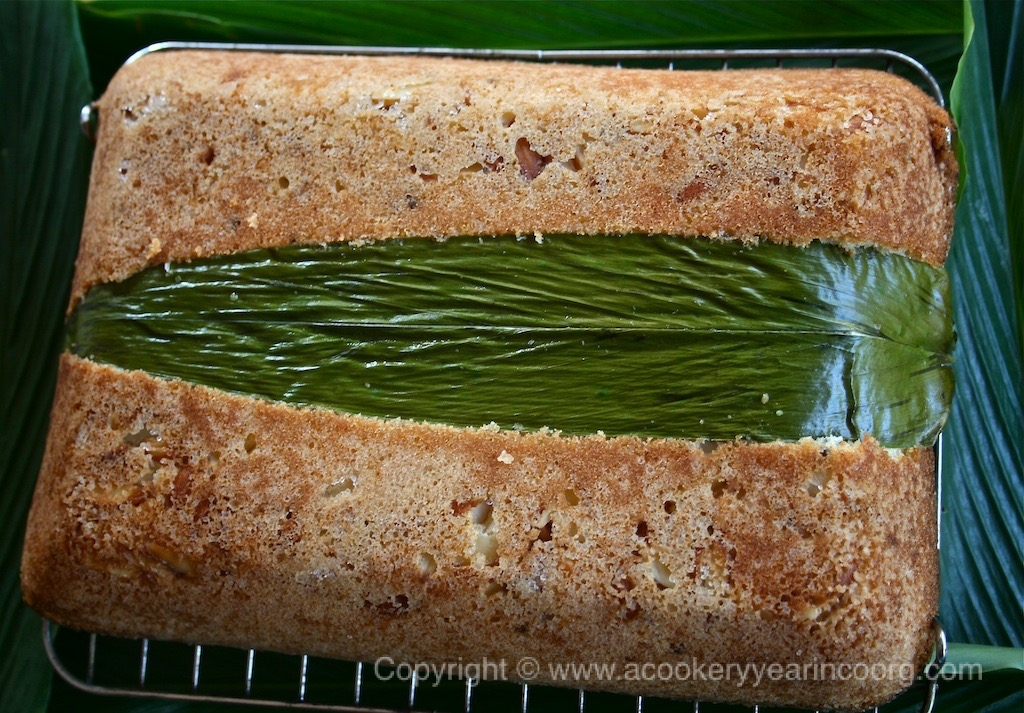

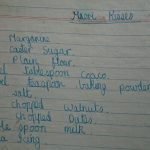
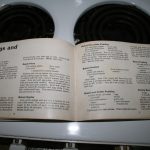
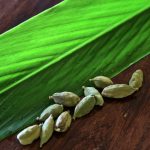
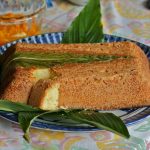
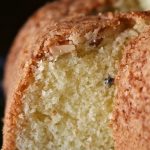
What a delightful story! Now we know where you’ve got your story telling genes from 🙂
I just made these cardamom twists last week. I used about a dozen pods and it still wasn’t very strong..
http://www.signejohansen.com/?p=1334#more-1334
Do you use the skin also or just the seeds?
How about posting your grandmothers seed cake recipe? (If there was one..)
Uma, this cake uses just the seeds, gently bruised. I’ve tried an assortment of leaves on the base, including fresh cassia, which got lost, and the rose geranium leaves that Niloufer suggests.That was just lovely.
I’m constantly surprised at how much cardamom the cake can absorb without it being too overwhelming. The cardamom twists sound delicious –must try!
My grandmother’s seed cake recipe, like everything she cooked, was stored in her memory. Sadly, I don’t think anyone thought to write things down when she was around.
In all the reminiscing about baking traditions, it’s still a mystery as to when and where she learned to bake so well.
Oh, and Bollu Thai was in a league of her own- they really don’t make ’em like they used to!:-)
Shalini, this is so beautifully written. I really enjoyed reading it, and you have created a picture so perfect that a visit to Coorg is now very high on my wishlist.
Plus a bonus recipe from Uma. 🙂
Thank you, ET! And yes, definitely plan a visit.:-)
What is amazing about this cake is that there is no leavening agent in it but it turns out so tender. I think I need to make it again.
This cake is a marvel. The first time I made it, I didn’t think I’d be able to whip up enough volume with the shaky eggbeater that was available, so I cheated and added a pinch of baking powder.Turns out it was unnecessary, and subsequent efforts have all been made without. Time for another round here too, methinks!
A lot of good cooks here in Chennai insist cardamom must be ground with skin for maximum flavour. I remember putting the skin in the water bottles carried to school; a few hours on the window sill made refreshing flavoured water 🙂
That makes sense, Uma, especially with really good, fresh cardamom, there’s plenty of fragrance in the skins. No waste! And when used in recipes like that Sindhi curry with the shocking amounts of cardamom, I guess the skins help thicken the sauce too.I must try that trick with the flavoured water!
Hi Shalini!
This one looks so yummy…will try it out soon. I enjoyed reading the fine details that you have considered while providing the background of this cake which makes it more beautiful than the actual making of it.
Will go through the rest of them soon.
Hi, and Welcome, Vidya!
Definitely try this cake out as soon as possible- you wont be disappointed.One bite, and you’ll see what I mean!
Great to see you here.Thanks for reading, and I hope you’ll enjoy browsing. 🙂
This is so true, Shalu…it just makes me weak-kneed thinking abt all those accomplished aunts….i always looked forward to the ‘tea and snacks’ during the wedding muhurtam, a lot more that the non-veg-laden lunch and dinner menu. I’ve eaten the best cakes and chocolate fudge ever, at a coorg weddings.
mother and daughter will definitely try out the cardamom cake…what exactly is a stick of butter?
talking abt baby bellings….yours looks HUGE! I’ve got my grandma’s old one tucked away under the kitchen counter and it’s really a ‘baby’…just enough for a 8″x6″ cake tray. But adorable
Kavitha, a stick of butter is 113gms, or 4 oz, so you can use something like one and a half of the 100gm packs of Amul butter.The recipe is quite forgiving and I have toyed with the butter, flour, and sugar quantities to no ill effect- it’s always delicious! If the eggs are small, just use an extra one.These conversions may be handy http://www.jsward.com/cooking/conversion.shtml
Those wedding “thindi” moments were the highlight for me too.The excitement of receiving large trays, laden with assorted goodies from various households was such a big part of the build up to a wedding. My Aunt, Shanthy, had to literally keep her famous chocolate fudge under lock and key before the event, to safeguard it from the marauding hordes!
I have to see your baby Baby Belling! I hope it’s still in working order.
What a marvelous marvelous cake . there is nothing like the smell of a freshly baked cake to welcome a child home form school and one that is redolent of cardamom . As A kid I do remember I could smell the cake the minute I opened the gate and it was a longish driveway to the front of the house . As always your writing is so delightful and you happily share so much information and the pics do justice to the cake . Some women are just natural chefs and your grandmother must have really loved to cook and feed . I recall now seeing the pictures of the kitchen both in its original form and the renovated version. I hope you will dedicate an extra special recipe to your grandmother with a picture of her . This I must try , am scared though about not using any baking powder . But you have reassured us , that there is no need > will try and let you know.
Welcome, backbencher!
This is indeed a wondrous cake, no question. Look at how far and long it has travelled, and continues to travel, since that first exchange between Ragnhild and Niloufer!
I’d say that’s reason enough to go boldly forth, pump up the volume in those eggs, and I’m sure you’ll never miss the baking powder.
My grandma’s life revolved around cooking for the extended family, and I am incredibly fortunate to have been able to spend so much time with her in the place where she was at her best- in her kitchen.
For that opportunity, I have to thank my parents, for hauling us across the country at regular intervals from wherever we happened to be posted, to spend time in Coorg.
Thank you for reading, and you can be sure there is just such a grandma’s special recipe coming up.:-)
And when you try out the cake, please do report to the front of the class!
Yes Ma’am 🙂
Shalini,
Your style of writing tugs at my heart strings and evokes images of another time and another place, filled with people who we have lost to time. My aunt , Shara, was one of the warmest, most loving women I have ever met. She was also a cook extraordinaire. My child hood memories of Coorg are peppered with images in Shara aunty’s house was always home made jams , cakes & souffles. The story you have so evocatively laid out here – about your Bollu Thayi , reminded me of the time when Shara aunty use to bake cakes with sand. I loved eating the cake , but was always reluctant to part with the sand from the sand pit. I remember making it difficult for the women who helped my aunty by rationing the amount of sand they could take from “my” sand pit. This recipe is one that I will try for sure….- I love how you do not limit yourself to just the traditional Kodava recipes – but borrow from other cultures as well. So, this Parsi delight, made with cardomom seeds from Coorg, will be made for tea , one of these days. I’ll circle back and report on how it turned out when I finally make it.
Hi Krupa,
Thank you for your kind words, and also for sharing some of those delightful moments from your childhood in Coorg! Isn’t it wonderful how, though most are long gone, those people who gave us some of the best times of our young lives, live on in the most comforting memories – mostly centred around food, naturally!
Do try this recipe when you get a chance. It is honestly one of the most brilliant cakes ever. I think what Coorgs share with the Parsi’s is an all embracing approach to good food. Thanks to those adventurous cooks like your Aunt, we grew up on wonderfully eclectic menus with the traditional standards, accented with happy borrowings from any and all cuisines that came their way. I think that “tradition” is worth preserving 🙂
I’ve been a bit slow with the indexing but it is nearly done and should be up shortly.
Thanks again for reading and sharing!
Hi Shalini,
Could you please index the recipes, so that it is easy to find? The only way I can get to them right now is to click on each post and search for them. Thanks!
Shalini, I did make the cake and my family loved it. So did one of my friends, whose opinion I value a great deal. Like your other readers, I was sceptical about baking without the baking soda, especially when the batter seemed like it had not risen much after the beating the eggs with a hand blender . However, the cakes turned beautifully ( I used 2 loaf plans) .I had a slope on one of them ( I neglected one of the tips – banging the pans on the counter to let the batter settle). Nonetheless, everybody loved them. Thanks once again! By the way, did you get the yellaki plant in Toronto. I loved the way the leaf looks on the cake.
That’s great to hear, Krupa! I’m willing to bet it’s going to be in regular rotation now. 🙂 I guess few of us make a good old fashioned sponge cake anymore so the lack of added leavening seems to require a leap of faith! I found this when reading a little about the Swedish tradition it comes from. It’s apparently what would be classified as a “Swedish visiting cake”- more here http://www.doriegreenspan.com/2007/03/swedish-visiting-cake.html
The yelakki leaves were all on cakes baked at home in Coorg. They do add a dramatic touch! Here in Vancouver it was always rose geranium leaves until I lost my little plant a couple of winters ago. Since then it’s been pretty much just the almond crust when I’m here.I have some other scented geraniums, including a pineapple one, which I should get around to trying.
Btw, I’ve put in the basic index (under contents at the top of the page) so hopefully you will find navigating a bit easier now. Thanks for reading and stopping by with feedback!